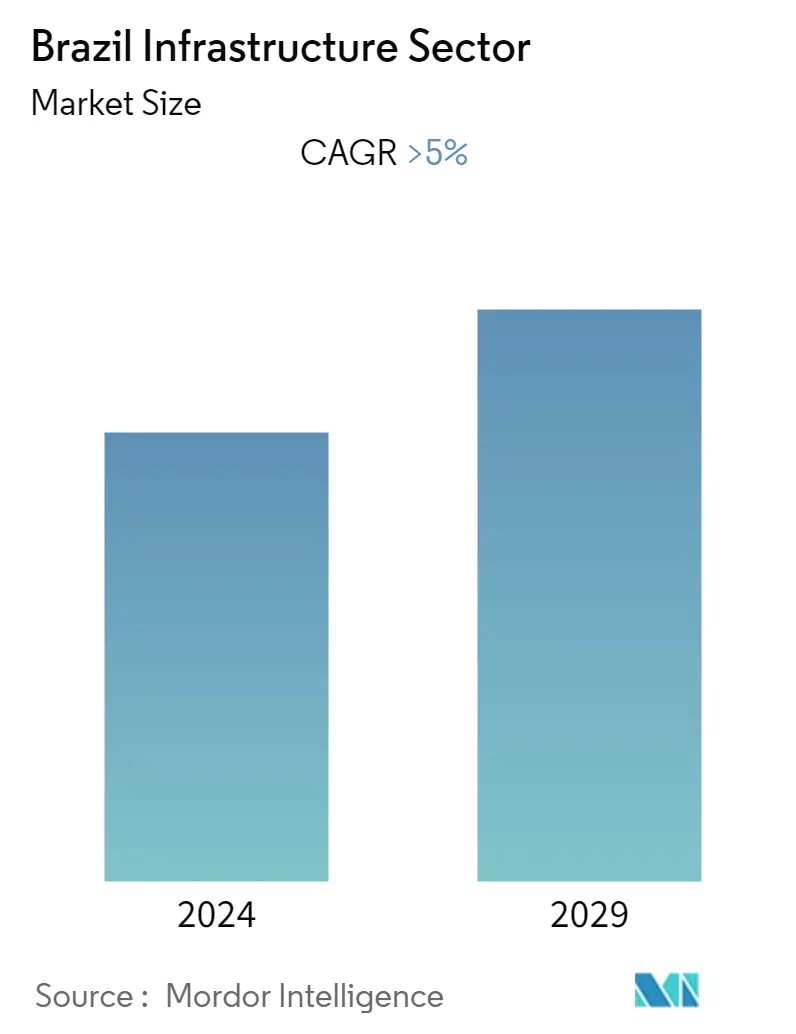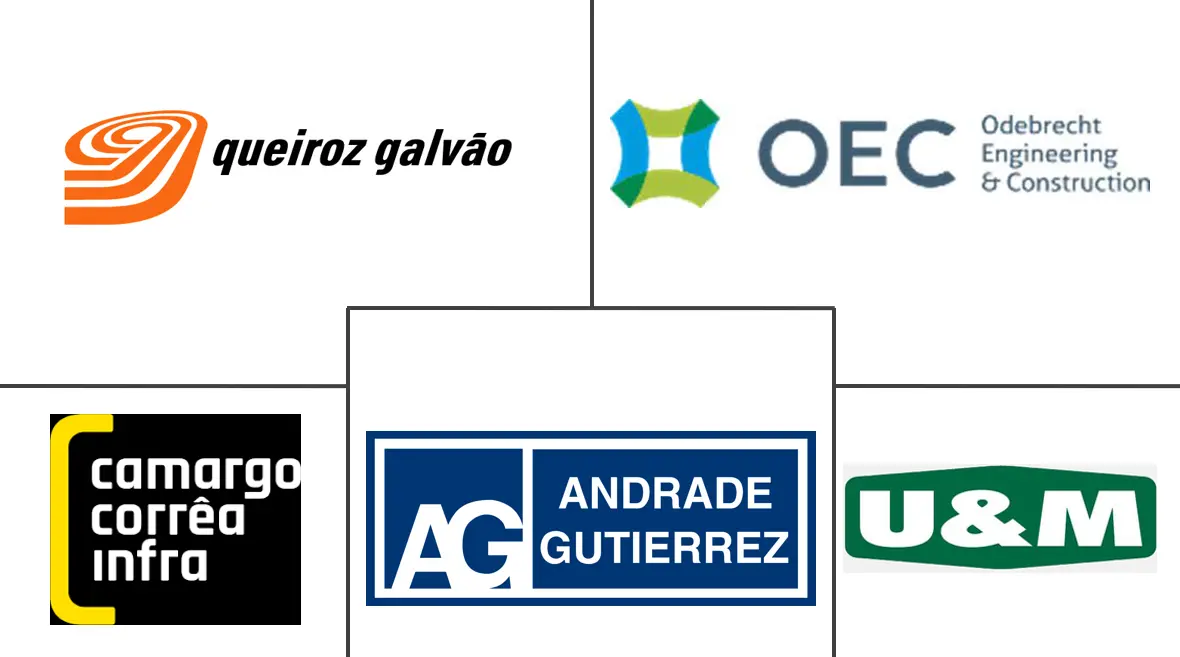Market Size of Brazil Infrastructure Sector

| Study Period | 2020 - 2029 |
| Base Year For Estimation | 2023 |
| Forecast Data Period | 2024 - 2029 |
| Historical Data Period | 2020 - 2022 |
| CAGR | > 5.00 % |
| Market Concentration | Medium |
Major Players
*Disclaimer: Major Players sorted in no particular order |
Brazil Infrastructure Market Analysis
The infrastructure sector in Brazil is expected to register a CAGR of more than 5% during the forecast period (2023-2028).
- In Brazil, the COVID-19 pandemic has not impacted all organizations and industries equally. Some industries performed well despite the pandemic, while others suffered due to restrictions and labor shortages. In addition, the healthcare sector recorded growth in the country, while telecommunications, media, and entertainment witnessed slight growth. The infrastructure sector is recovering as the manufacturing, transportation, and other sectors started full-fledged operations.
- In 2021, an 18-month engagement program was planned between the Global Infrastructure Hub (GI Hub) and the Brazilian government to attract more private sector investment into infrastructure and bring further bankable projects. In addition, between 2020 and 2022, the Brazilian government planned to bring more than USD 44 billion in infrastructure projects to auction and seek private participation in successful projects that meet Brazil's sustainability and resilience objectives.
- In 2022, the country received more than half of South America's total incoming foreign direct investments, with the United States as one of the significant supporters. In addition, the initiation of new developments and upcoming auctions in the energy and transportation sectors in the country may fuel new partnerships with investors worldwide.
Brazil Infrastructure Industry Segmentation
Infrastructure is the backbone of domestic and international commerce and industrial and agricultural production. It is the fundamental organizational and physical framework necessary to operate a firm successfully. Basic infrastructure in an organization or a nation comprises communication and transportation, sewage, water, a health and education system, safe drinking water, and a monetary system.
the infrastructure sector in brazil is segmented by type (social infrastructure (schools, hospitals, defense, other infrastructure), transportation infrastructure (railways, roadways, airports, ports, waterways), extraction infrastructure (oil and gas, other extraction (minerals, metals, coal), utilities infrastructure (power generation, electricity transmission and distribution, water, gas, telecoms), manufacturing infrastructure (metal and ore production, petroleum refining, chemical manufacturing, industrial parks and clusters, other infrastructure)) and key cities (Sao Paulo, Rio de Janeiro, and Salvador). The report offers the market sizes and forecasts for the market in value (USD) for all the above segments.
| By Type | |||||||
| |||||||
| |||||||
| |||||||
|
| By Key Cities | |
| Sao Paulo | |
| Rio de Janeiro | |
| Salvador |
Brazil Infrastructure Sector Size Summary
The infrastructure sector in Brazil is poised for significant growth, driven by a robust recovery post-pandemic and increasing foreign investment confidence. The sector is experiencing a resurgence as manufacturing and transportation industries resume full operations. The Brazilian government has been proactive in attracting private sector investments through initiatives like the Global Infrastructure Hub's engagement program and substantial infrastructure project auctions. These efforts are supported by reforms aimed at reducing business costs and enhancing investment appeal, such as the Sanitation Law and the New Highway Concession Design. The transportation infrastructure, in particular, is a key growth driver, with numerous auctions for airports, highways, railways, and ports planned, further bolstering the sector's expansion.
In addition to transportation, Brazil's energy sector is gaining traction, with a focus on renewable energy investments, aligning with global sustainability trends. The country's energy matrix is predominantly renewable, attracting significant foreign interest. Meanwhile, the education and healthcare sectors are also witnessing growth, fueled by increased funding and investments post-pandemic. Initiatives like the World Bank's support for educational recovery and investments in healthcare infrastructure underscore the sector's development. The market is characterized by a fragmented landscape with major players such as Construtora Queiroz Galvão and Camargo Corrêa Infra Construções, contributing to the sector's dynamic growth trajectory.
Brazil Infrastructure Sector Market Size - Table of Contents
-
1. MARKET INSIGHTS AND DYNAMICS
-
1.1 Current Economic and Construction Market Scenario
-
1.2 Impact of Government Regulations and Initiatives on the Industry
-
1.3 Supply Chain/Value Chain Analysis
-
1.4 Technology Snapshot and Digital Trends
-
1.5 Insights on Modernization of the Transportation Infrastructure Sector
-
1.6 Insights on Major Infrastructure Development Projects
-
1.7 Insights on Ongioing and Upcoming Infrastructure Projects
-
1.8 Market Dynamics
-
1.8.1 Market Drivers
-
1.8.2 Market Restraints
-
1.8.3 Market Opportunities
-
-
1.9 Porter's Five Forces Analysis
-
1.10 Impact of COVID-19 on the Market
-
-
2. MARKET SEGMENTATION
-
2.1 By Type
-
2.1.1 Social Infrastructure
-
2.1.1.1 Schools
-
2.1.1.2 Hospitals
-
2.1.1.3 Defence
-
2.1.1.4 Other Social Infrastructures
-
-
2.1.2 Transportation Infrastructure
-
2.1.2.1 Railways
-
2.1.2.2 Roadways
-
2.1.2.3 Airports
-
2.1.2.4 Waterways
-
-
2.1.3 Extraction Infrastructure
-
2.1.3.1 Power Generation
-
2.1.3.2 Electricity Transmission and Distribution
-
2.1.3.3 Water
-
2.1.3.4 Gas
-
2.1.3.5 Telecoms
-
-
2.1.4 Manufacturing Infrastructure
-
2.1.4.1 Metal and Ore Production
-
2.1.4.2 Petroleum Refining
-
2.1.4.3 Chemical Manufacturing
-
2.1.4.4 Industrial Parks and clusters
-
2.1.4.5 Other Manufacturing Infrastructures
-
-
-
2.2 By Key Cities
-
2.2.1 Sao Paulo
-
2.2.2 Rio de Janeiro
-
2.2.3 Salvador
-
-
Brazil Infrastructure Sector Market Size FAQs
What is the current Brazil Infrastructure Market size?
The Brazil Infrastructure Market is projected to register a CAGR of greater than 5% during the forecast period (2024-2029)
Who are the key players in Brazil Infrastructure Market?
OEC, Andrade Gutierrez, Construtora Queiroz Galvão, Camargo Corrêa Infra Construções and U&M Mineração e Construção are the major companies operating in the Brazil Infrastructure Market.

